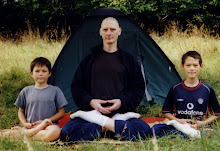Sakyamuni Buddha told a great gathering:
"In full lotus sitting, the body-mind experience of samadhi, there is dignity that many respect. Like the sun lighting up the world, it clears away sleepy, lazy and sad states of mind. The body is light and tireless. Consciousness is also light and quick. Sit at ease, like dragons coiling! The king of demons is frightened on seeing even a picture of lotus sitting -- let alone a person experiencing enlightenment, sitting at ease without leaning or moving."
Thus, to observe just a depiction of lotus sitting makes the king of demons surprised, worried and afraid. Still more, when lotus sitting is really practised, its benefits are impossible to fathom. In short, everday sitting is happiness and good beyond measure.
Translated on the basis of the teaching of FM Alexander -- starting with the principle that sitting at ease is a very rare flower that can only blossom in the absence of fear of being wrong/trying to be right; and avoiding any mention of the word "posture" -- on the morning of 24th April 2008.
Thursday, 24 April 2008
Subscribe to:
Post Comments (Atom)

1 comment:
When Gudo suggested to me three years ago that I follow Michael Luetchford's example with Nagarjuna's MMK, and make my own independent translation of Shobogenzo, "based on AT theory," I saw that as an outrageous suggestion. But, if I give up the idea of remaining loyal to my old teacher (who did his best to teach me), and give up the idea of remaining loyal to my old translation partner (who was duped by the Luetchfords into betraying our fifty-fifty agreement), then it is not such an outrageous proposition after all.
The Nishijima-Cross translation of 1994-1998 was based on the principle of trying to be right. At the centre of Gudo's interpretation were fixed conceptions about right posture ("keep the spine straight vertically") and right state of mind ("balance of the autonomic nervous system"). From my side, I wanted to be a true servant of a true Buddhist teacher. To that end, I tended to try hard to make both myself and my teacher, and to make our joint translation, fit my conception of rightness -- which, unfortunately, was generally wrong.
A translation based on AT theory would be based on the conception which is the dialectic opposite of trying to be right -- namely, daring to be wrong. So maybe there can be at least two versions: the complete trying to be right version of 1994-1998, and an off the top of a demon's head at random version of 2008 --> ?
The process of translating based on AT theory might begin, for example, with the thought, when a stimulus to try to be right reaches the translator's consciousness, "No, fuck that for a game of cards." Out of that kind of non-thinking might something worthwhile spontaneously emerge?
I would like to think so. There again, all my experience so far has proved to me that when I think I am free of trying to be right, it is invariably not so.
Contrary to my habitual conceptions of what freedom is, in reality there can be freedom in slavishly following a master who is not right, and there can be fixity in attaching to a teaching that points in a direction which is right.
Maybe, as part of the background to the Buddha's exhortation to sit at ease, is the realization that habitual conceptions are baggage that a sitting dragon does not bother to carry around.
Post a Comment